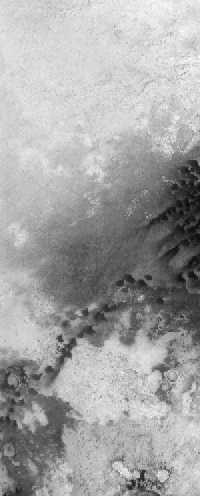
|

|

Roughly four months ago, Bill Stanley and Woodlock gave this image from the Mars Global Surveyor MOC Image 10004 - Browse Page,
10004.jpg one last look before they were to cast it into the recycle bin. It is Image 4 captured by the Mars Global Surveyor during Orbit 100, on January 21, 1998, with it's Narrow Angle Camera during the Orbit Insertion Phase of the mission.
The image has a Center Latitude of -46.92 and Center Longitude of 341.17
Conspiratorialists may find it of interest the anomalies in question are at the precise center of the 1600 x 3968 pixel image.
To better visualize the location of the Orionia region on the Martian sphere go to the Mars Global Surveyor MOC Images - Main Page. The data for NA010004.GIF can be found within the first southern quadrant to the right of 0 degrees longitude.
A closer view of the Orionia region. On this enlargement, the objects depicting the constellation of Orion are not yet visible.
The Orionia region is coming into view. In this image, the brightness is adjusted slightly.
This is the view that should capture the eye of any skywatcher.
THE CONSTELLATION
THE STARS
THE ENHANCEMENTS
The picture below shows the Egyptian Pyramids on the Giza Plateau from orbit. It was taken by the
Spaceborne Imaging Radar-C/X-Band Synthetic
Aperture Radar aboard the shuttle Endeavour on April 19, 1994.
By now you must be wondering why we circled the object just below the "belt" of Orion -- if it is indeed Orion. It is the only object that doesn't correspond to a prominent star in the constellation. And under close examination, it does bear a slight resemblance to a pyramid, as evidenced by the appearance from orbit of the Giza Pyramids.
So, if the landmarks were plotted out according to the position of the stars thousands, or millions of years ago...the circled object could be a "marker" of some sort. It is roughly 15 pixels wide. Given the resolution of the image (approximately 10 meters per pixel), the "marker" would have a base of 150 meters, or slightly smaller than the Great Pyramid in Egypt. The objects representing the "belt" stars would therefore be similar in size (and distance apart) as the pyramids on the Giza Plateau.
If it is a "marker" or pyramid, perhaps it's the Hall Of Records Edgar Cayce predicted would be discovered in the final years of the twentieth century.
Maybe the marker represents the location of a planetary system from where ancient astronauts came to visit the earth. You may find it of interest that numerous G-Type stars
(Sunlike) are near those celestial coordinates and within 30 lightyears of the Sun.
And how did this object manage to appear at the exact center of the MOC image? A bizarre fluke? Or pin-point targeting by mission specialists at NASA?
Conclusions? No. Only questions. When the Orionia Region is imaged anew by the Mars Global Surveyor, we might have another opportunity to solve the ORION ENIGMA! |